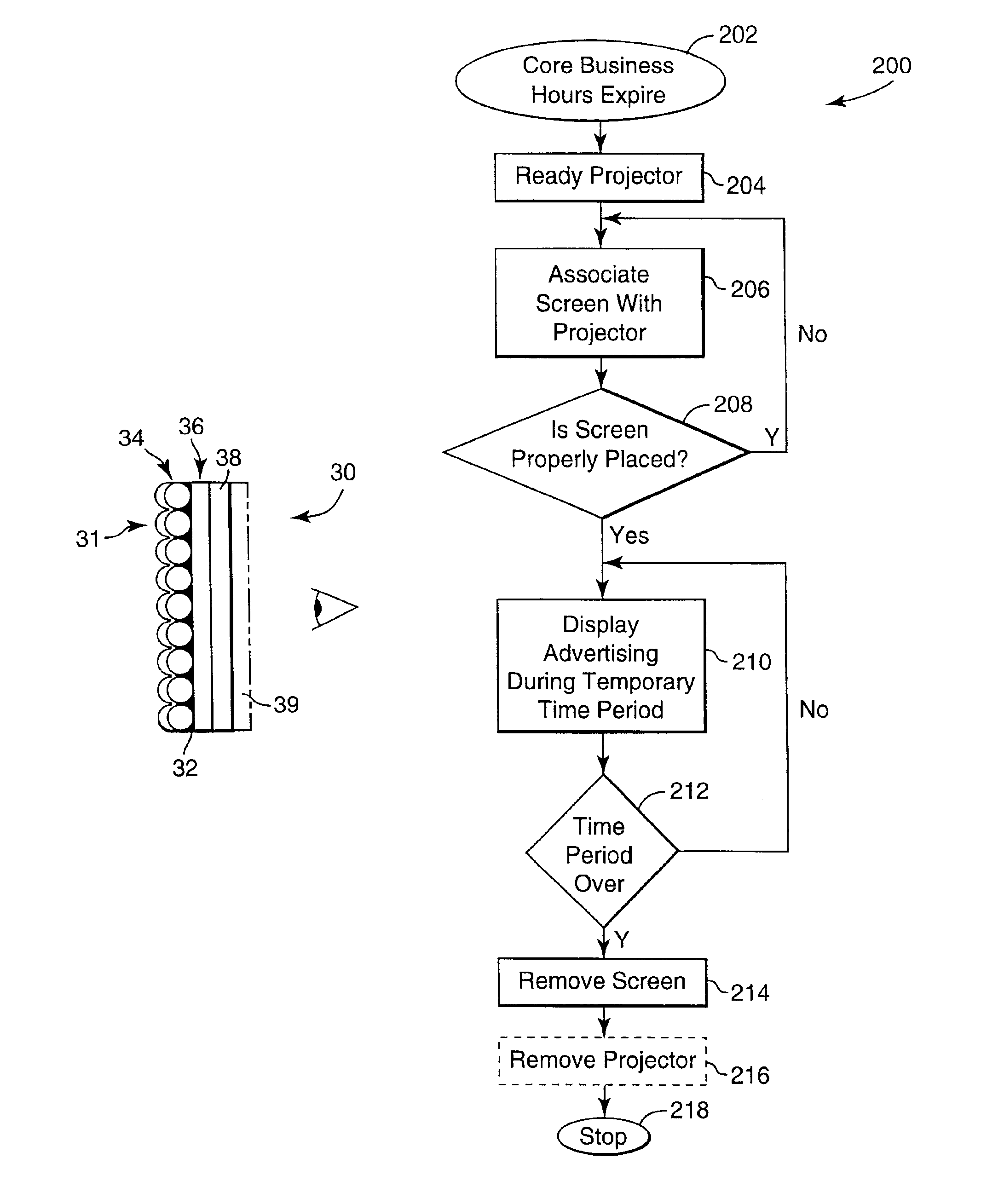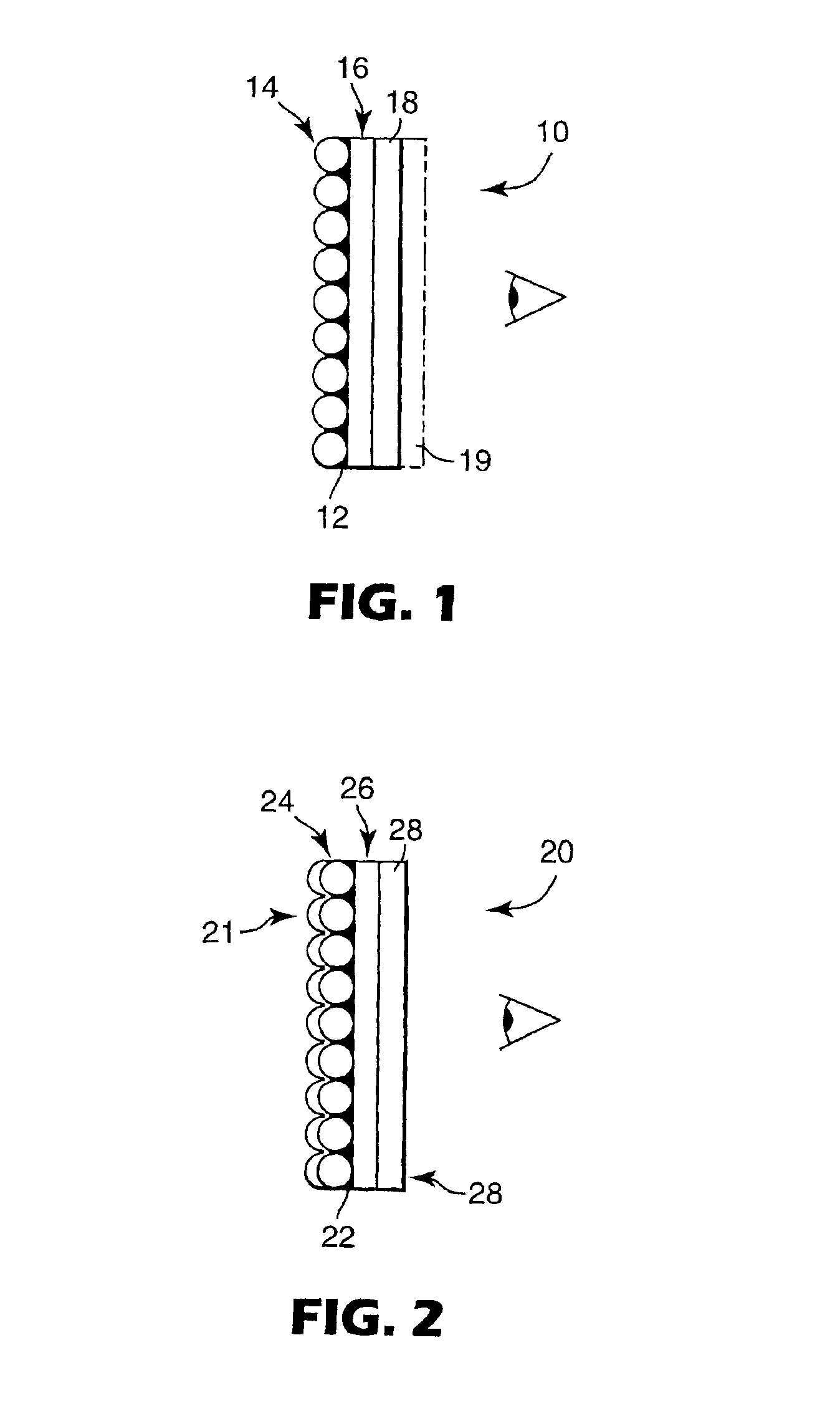Screens and methods for displaying information
a technology of information screens and screens, applied in the field of optical systems, can solve the problems of inability to conveniently roll an inflexible projection screen, fading or washout of the projected image, and the rear projection screen is sensitive to ambient lighting conditions, and achieves high contrast, high resolution, and easy mounting.
- Summary
- Abstract
- Description
- Claims
- Application Information
AI Technical Summary
Benefits of technology
Problems solved by technology
Method used
Image
Examples
example 1
A monolayer glass beaded film similar to that shown in FIG. 15 B was provided. The film comprises a monolayer of glass bead of approximately 65 micrometers, an opaque black matrix (urethane and carbon black) and a polyvinyl chloride substrate. The beads had a refractive index of about 1.9. The film is generally available from Minnesota Mining and Manufacturing Company of St. Paul, Minn. under the name BePF 120 beaded film. The screen was attached to a glass window using Scotch Glue Stick Restickable Adhesive (3M catalog #6314) generally available from Minnesota Mining and Manufacturing Company of St. Paul, Minn. The film plus the adhesive was approximately 6 mils thick. The adhesive was not coated over the entire viewing surface of the screen. Instead, the adhesive was only placed on the four comers of the beaded film screen. The assembly provided a secure, releasable attachment to the window.
The assembly was coupled to a Toshiba LCD Data Projector, number TLP 710 and video was view...
example 2
Beaded Film Laminated to PVC Film
A monolayer glass beaded film similar to that described in Example 1 was provided. The film comprises a monolayer of glass bead of approximately 65 micrometers in diameter, an opaque black matrix (urethane and carbon black) and a polyvinyl chloride substrate. The film is generally available from Minnesota Mining and Manufacturing Company of St. Paul, Minn. under the name BePF 120 beaded film. A 10 mil thick plasticized PVC film (KGC193 Clear PVC Film from Achilles USA, Inc.) was laminated to the non-beaded side of the beaded film using the pressure sensitive adhesive 3M Opt-1 Laminating adhesive (also known as Bonding Systems Division 9483 adhesive) available from 3M. The screen was approximately 20 mils thick. This assembly was pressed against a glass window to provide a secure, releasable and reusable attachment of the screen to the window. The material is also believed to be washable.
example 3
Beaded Film Laminated with Ethylene Vinyl Acetate
A monolayer glass beaded film similar to that described in Example 1 was provided. The film comprises a monolayer of glass bead of approximately 65 micrometers in diameter, an opaque black matrix (urethane and carbon black) and a polyvinyl chloride substrate. The film is generally available from Minnesota Mining and Manufacturing Company of St. Paul, Minn. under the name BePF 120 beaded film. An ethylene vinyl acetate film (EVA Elvax from Dupont, 5 mils thick) was laminated to the polyvinyl chloride substrate. No additional adhesive was needed to attach the BePF 120 to the EVA. The screen was approximately 11 mils thick. The assembly provided a secure, releasable and reusable attachment of the screen to the window. Adhesion by static cling is believed to hold the EVA film firmly to the BePF 120 and provides attachment of the assembly to the window. The material is also believed to be washable.
PUM
 Login to View More
Login to View More Abstract
Description
Claims
Application Information
 Login to View More
Login to View More - R&D
- Intellectual Property
- Life Sciences
- Materials
- Tech Scout
- Unparalleled Data Quality
- Higher Quality Content
- 60% Fewer Hallucinations
Browse by: Latest US Patents, China's latest patents, Technical Efficacy Thesaurus, Application Domain, Technology Topic, Popular Technical Reports.
© 2025 PatSnap. All rights reserved.Legal|Privacy policy|Modern Slavery Act Transparency Statement|Sitemap|About US| Contact US: help@patsnap.com



